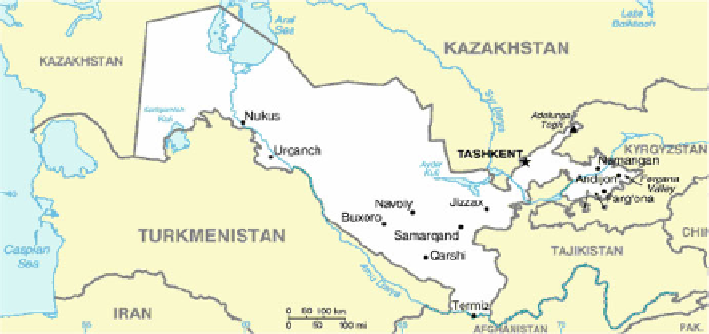Geoscience Reference
In-Depth Information
Fig. 13.1
Bordering Turkmenistan to the southwest, Kazakhstan to the north, and Tajikistan and
Kyrgyzstan to the south and east, Uzbekistan is not only one of the larger Central Asian states but
also the only Central Asian state to border all of the other four former Soviet Republics. Uzbekistan
also shares a short border with Afghanistan to the south
Water resources, which are unevenly distributed, are in short supply in most of
Uzbekistan. The vast plains that occupy two-thirds of Uzbekistan's territory have
little water, and there are few lakes. The two largest rivers feeding Uzbekistan are
the Amu Darya and the Syrdariya, which originate in the mountains of Tajikistan
and Kyrgyzstan, respectively. These rivers form the two main river basins of Central
Asia; they are used primarily for irrigation, and several artificial canals have been
built to expand the supply of arable land in the Fergana Valley, Mirzachuli steppe
and Aral Sea Basin.
Around 255,000 km
2
or 57 % of the country are rangelands. They have
traditionally been used as common grazing lands for livestock. About 78 % of the
rangeland cover is desert and semidesert plains (Gintzburger et al.
2003
). Most of
the farming in Uzbekistan's desert rangeland regions is Karakul sheep husbandry,
followed by goat, camel and horse husbandry. The total number of head is greater
than ten million (Mahmudov
2006
). More than 2.3 million people are entirely
dependent on livestock production for food and economic security (Yusupov
2003
).
The natural
Artemisia
-ephemeral and ephemeroidal rangelands are the main grazing
lands for sheep and goats, and have been throughout history. Ninety-five percent of
their total diet comes directly from the grazing and the remaining is harvested by
the farmers and local herders and used when no grazing is available. Anthropogenic
impact, on top of abiotic disturbances, is thus a part of the disturbance regime this
area has been exposed to through the ages. High localized anthropogenic impact
often results in rapid land degradation and even desertification, hence altering the
native vegetation cover of rangeland areas. The human footprint has increased with
the ever-growing human population, as can be seen in the expansion of degraded
rangelands in Uzbekistan.

Search WWH ::

Custom Search